Business Communication Skills: Comparative Study of Two Articles
VerifiedAdded on 2021/05/30
|11
|2178
|50
Report
AI Summary
This report presents a comparative analysis of two articles related to business communication skills and workplace culture. The first article, "Six Components of a Great Corporate Culture," by John Coleman, emphasizes the importance of vision, values, practices, people, narrative, and place in shaping organizational culture. The second article, "The Value of Corporate Culture," by Guiso, Sapienza, and Zingales, highlights the significance of culture as a form of social control and its impact on corporate performance. The report identifies differences in the arguments presented in the articles, with the second article viewed as an extended version of the first, providing a deeper theoretical consideration of the importance of organizational values. The report recommends involving employees in group discussions, developing effective HR policies, and fostering a safe and comfortable workplace to maintain and enhance corporate culture. The conclusion underscores the significance of ethical approaches and continuous evaluation in preserving organizational values and promoting cultural diversity within the workplace. This report is available on Desklib, a platform providing AI-based study tools.

Running head: BUSINESS COMMUNICATION SKILLS
Comparative study between two articles
Name of the student:
Name of the university:
Author note:
Comparative study between two articles
Name of the student:
Name of the university:
Author note:
Paraphrase This Document
Need a fresh take? Get an instant paraphrase of this document with our AI Paraphraser
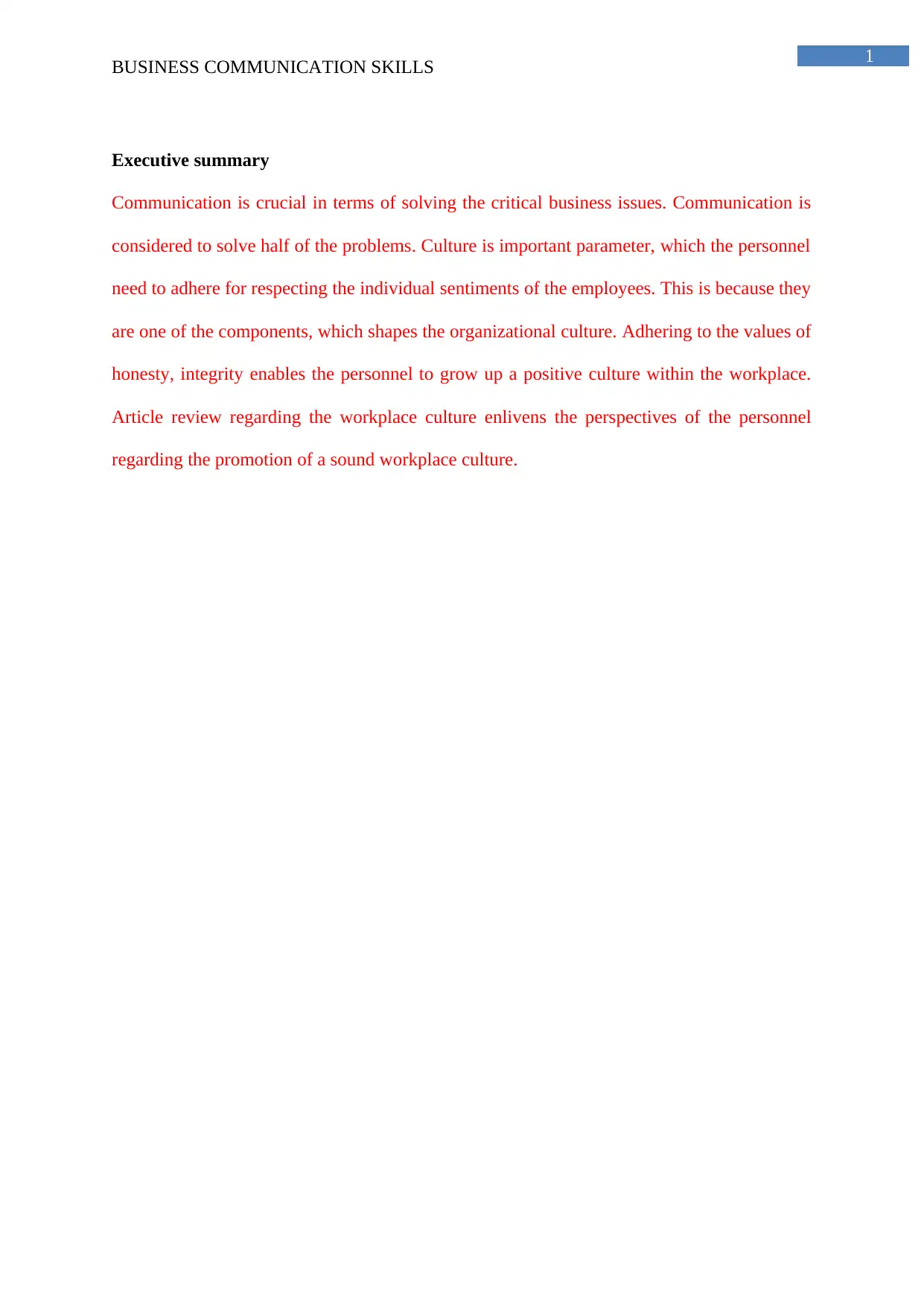
1
BUSINESS COMMUNICATION SKILLS
Executive summary
Communication is crucial in terms of solving the critical business issues. Communication is
considered to solve half of the problems. Culture is important parameter, which the personnel
need to adhere for respecting the individual sentiments of the employees. This is because they
are one of the components, which shapes the organizational culture. Adhering to the values of
honesty, integrity enables the personnel to grow up a positive culture within the workplace.
Article review regarding the workplace culture enlivens the perspectives of the personnel
regarding the promotion of a sound workplace culture.
BUSINESS COMMUNICATION SKILLS
Executive summary
Communication is crucial in terms of solving the critical business issues. Communication is
considered to solve half of the problems. Culture is important parameter, which the personnel
need to adhere for respecting the individual sentiments of the employees. This is because they
are one of the components, which shapes the organizational culture. Adhering to the values of
honesty, integrity enables the personnel to grow up a positive culture within the workplace.
Article review regarding the workplace culture enlivens the perspectives of the personnel
regarding the promotion of a sound workplace culture.
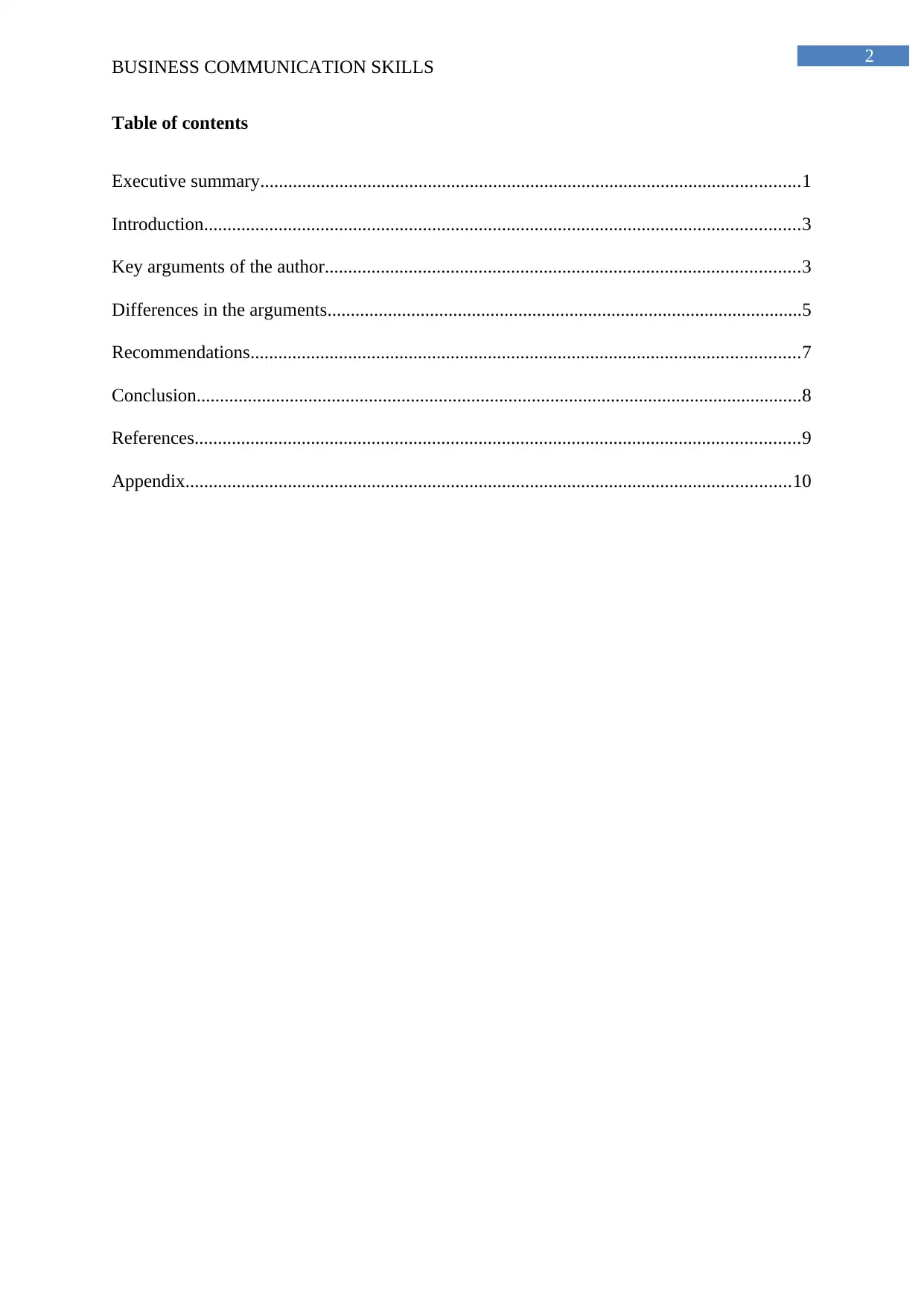
2
BUSINESS COMMUNICATION SKILLS
Table of contents
Executive summary....................................................................................................................1
Introduction................................................................................................................................3
Key arguments of the author......................................................................................................3
Differences in the arguments......................................................................................................5
Recommendations......................................................................................................................7
Conclusion..................................................................................................................................8
References..................................................................................................................................9
Appendix..................................................................................................................................10
BUSINESS COMMUNICATION SKILLS
Table of contents
Executive summary....................................................................................................................1
Introduction................................................................................................................................3
Key arguments of the author......................................................................................................3
Differences in the arguments......................................................................................................5
Recommendations......................................................................................................................7
Conclusion..................................................................................................................................8
References..................................................................................................................................9
Appendix..................................................................................................................................10
⊘ This is a preview!⊘
Do you want full access?
Subscribe today to unlock all pages.

Trusted by 1+ million students worldwide
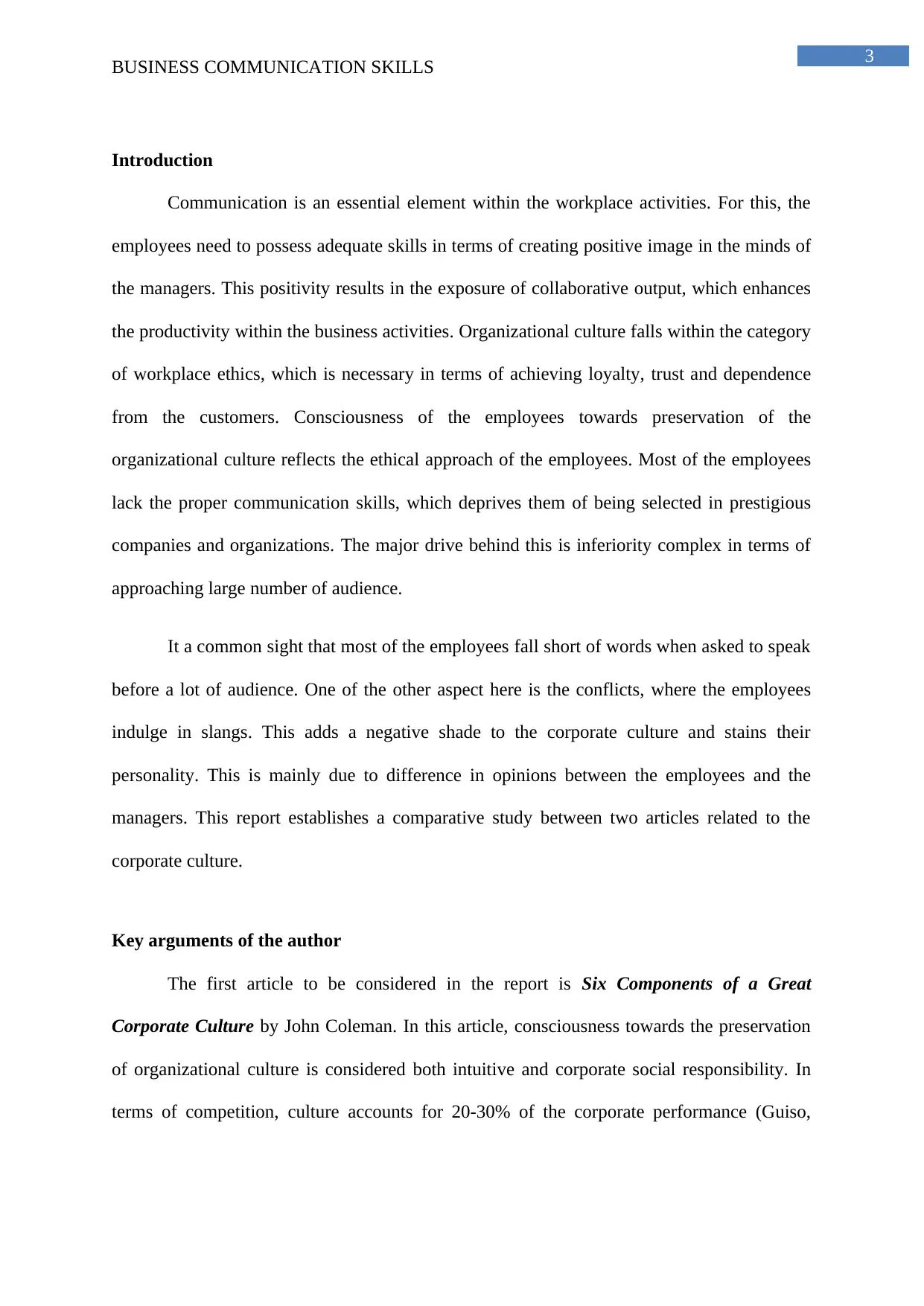
3
BUSINESS COMMUNICATION SKILLS
Introduction
Communication is an essential element within the workplace activities. For this, the
employees need to possess adequate skills in terms of creating positive image in the minds of
the managers. This positivity results in the exposure of collaborative output, which enhances
the productivity within the business activities. Organizational culture falls within the category
of workplace ethics, which is necessary in terms of achieving loyalty, trust and dependence
from the customers. Consciousness of the employees towards preservation of the
organizational culture reflects the ethical approach of the employees. Most of the employees
lack the proper communication skills, which deprives them of being selected in prestigious
companies and organizations. The major drive behind this is inferiority complex in terms of
approaching large number of audience.
It a common sight that most of the employees fall short of words when asked to speak
before a lot of audience. One of the other aspect here is the conflicts, where the employees
indulge in slangs. This adds a negative shade to the corporate culture and stains their
personality. This is mainly due to difference in opinions between the employees and the
managers. This report establishes a comparative study between two articles related to the
corporate culture.
Key arguments of the author
The first article to be considered in the report is Six Components of a Great
Corporate Culture by John Coleman. In this article, consciousness towards the preservation
of organizational culture is considered both intuitive and corporate social responsibility. In
terms of competition, culture accounts for 20-30% of the corporate performance (Guiso,
BUSINESS COMMUNICATION SKILLS
Introduction
Communication is an essential element within the workplace activities. For this, the
employees need to possess adequate skills in terms of creating positive image in the minds of
the managers. This positivity results in the exposure of collaborative output, which enhances
the productivity within the business activities. Organizational culture falls within the category
of workplace ethics, which is necessary in terms of achieving loyalty, trust and dependence
from the customers. Consciousness of the employees towards preservation of the
organizational culture reflects the ethical approach of the employees. Most of the employees
lack the proper communication skills, which deprives them of being selected in prestigious
companies and organizations. The major drive behind this is inferiority complex in terms of
approaching large number of audience.
It a common sight that most of the employees fall short of words when asked to speak
before a lot of audience. One of the other aspect here is the conflicts, where the employees
indulge in slangs. This adds a negative shade to the corporate culture and stains their
personality. This is mainly due to difference in opinions between the employees and the
managers. This report establishes a comparative study between two articles related to the
corporate culture.
Key arguments of the author
The first article to be considered in the report is Six Components of a Great
Corporate Culture by John Coleman. In this article, consciousness towards the preservation
of organizational culture is considered both intuitive and corporate social responsibility. In
terms of competition, culture accounts for 20-30% of the corporate performance (Guiso,
Paraphrase This Document
Need a fresh take? Get an instant paraphrase of this document with our AI Paraphraser
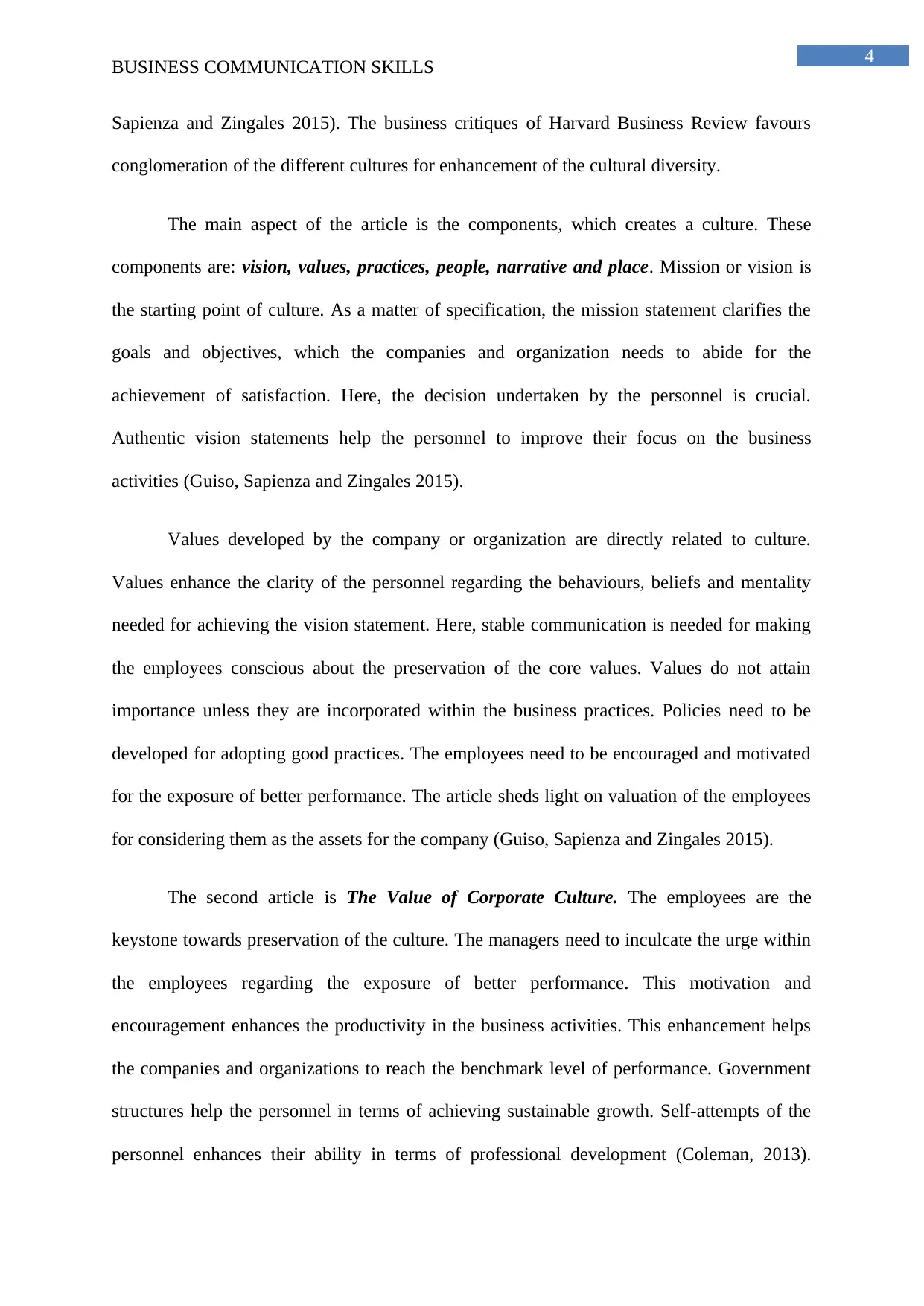
4
BUSINESS COMMUNICATION SKILLS
Sapienza and Zingales 2015). The business critiques of Harvard Business Review favours
conglomeration of the different cultures for enhancement of the cultural diversity.
The main aspect of the article is the components, which creates a culture. These
components are: vision, values, practices, people, narrative and place. Mission or vision is
the starting point of culture. As a matter of specification, the mission statement clarifies the
goals and objectives, which the companies and organization needs to abide for the
achievement of satisfaction. Here, the decision undertaken by the personnel is crucial.
Authentic vision statements help the personnel to improve their focus on the business
activities (Guiso, Sapienza and Zingales 2015).
Values developed by the company or organization are directly related to culture.
Values enhance the clarity of the personnel regarding the behaviours, beliefs and mentality
needed for achieving the vision statement. Here, stable communication is needed for making
the employees conscious about the preservation of the core values. Values do not attain
importance unless they are incorporated within the business practices. Policies need to be
developed for adopting good practices. The employees need to be encouraged and motivated
for the exposure of better performance. The article sheds light on valuation of the employees
for considering them as the assets for the company (Guiso, Sapienza and Zingales 2015).
The second article is The Value of Corporate Culture. The employees are the
keystone towards preservation of the culture. The managers need to inculcate the urge within
the employees regarding the exposure of better performance. This motivation and
encouragement enhances the productivity in the business activities. This enhancement helps
the companies and organizations to reach the benchmark level of performance. Government
structures help the personnel in terms of achieving sustainable growth. Self-attempts of the
personnel enhances their ability in terms of professional development (Coleman, 2013).
BUSINESS COMMUNICATION SKILLS
Sapienza and Zingales 2015). The business critiques of Harvard Business Review favours
conglomeration of the different cultures for enhancement of the cultural diversity.
The main aspect of the article is the components, which creates a culture. These
components are: vision, values, practices, people, narrative and place. Mission or vision is
the starting point of culture. As a matter of specification, the mission statement clarifies the
goals and objectives, which the companies and organization needs to abide for the
achievement of satisfaction. Here, the decision undertaken by the personnel is crucial.
Authentic vision statements help the personnel to improve their focus on the business
activities (Guiso, Sapienza and Zingales 2015).
Values developed by the company or organization are directly related to culture.
Values enhance the clarity of the personnel regarding the behaviours, beliefs and mentality
needed for achieving the vision statement. Here, stable communication is needed for making
the employees conscious about the preservation of the core values. Values do not attain
importance unless they are incorporated within the business practices. Policies need to be
developed for adopting good practices. The employees need to be encouraged and motivated
for the exposure of better performance. The article sheds light on valuation of the employees
for considering them as the assets for the company (Guiso, Sapienza and Zingales 2015).
The second article is The Value of Corporate Culture. The employees are the
keystone towards preservation of the culture. The managers need to inculcate the urge within
the employees regarding the exposure of better performance. This motivation and
encouragement enhances the productivity in the business activities. This enhancement helps
the companies and organizations to reach the benchmark level of performance. Government
structures help the personnel in terms of achieving sustainable growth. Self-attempts of the
personnel enhances their ability in terms of professional development (Coleman, 2013).
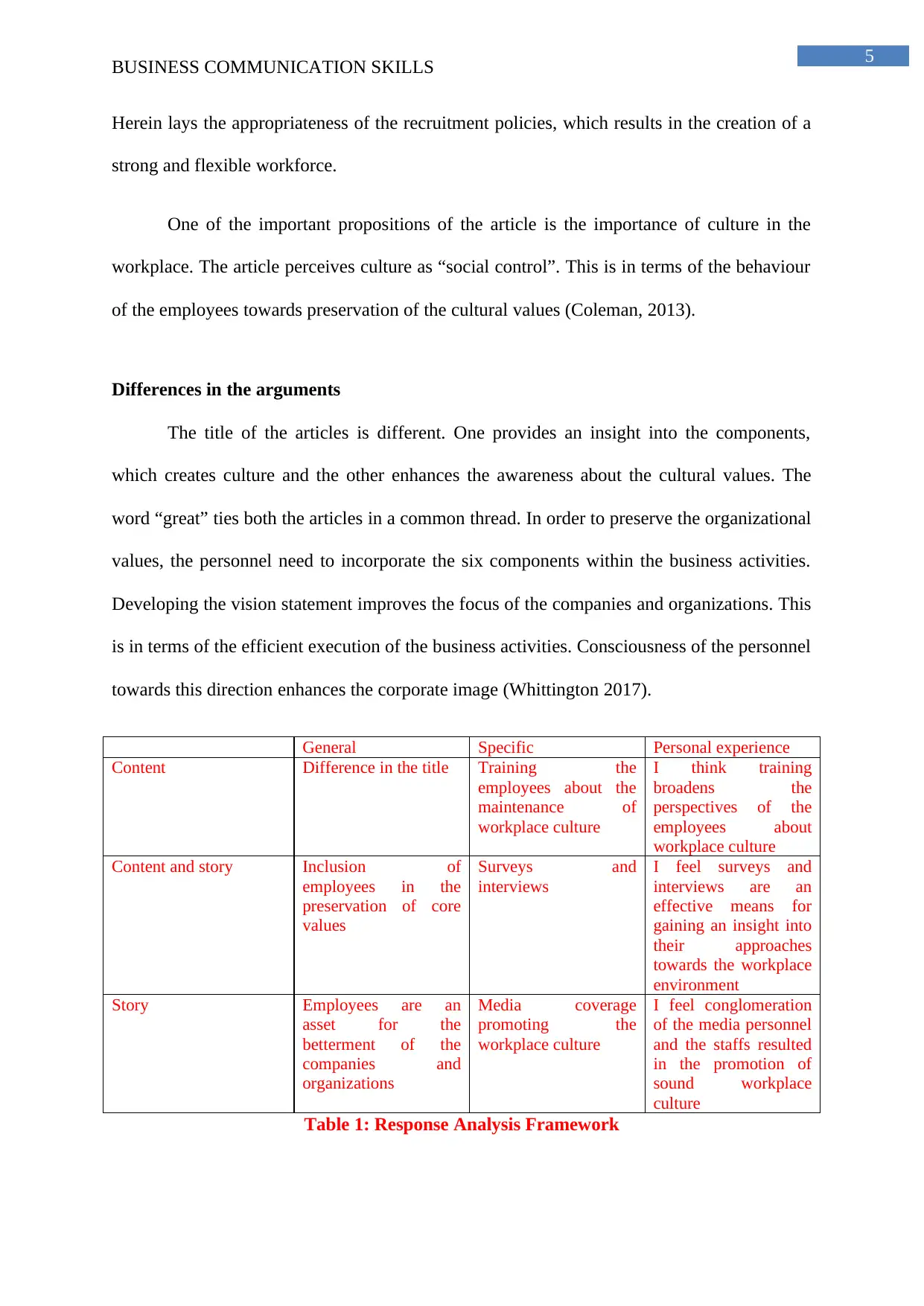
5
BUSINESS COMMUNICATION SKILLS
Herein lays the appropriateness of the recruitment policies, which results in the creation of a
strong and flexible workforce.
One of the important propositions of the article is the importance of culture in the
workplace. The article perceives culture as “social control”. This is in terms of the behaviour
of the employees towards preservation of the cultural values (Coleman, 2013).
Differences in the arguments
The title of the articles is different. One provides an insight into the components,
which creates culture and the other enhances the awareness about the cultural values. The
word “great” ties both the articles in a common thread. In order to preserve the organizational
values, the personnel need to incorporate the six components within the business activities.
Developing the vision statement improves the focus of the companies and organizations. This
is in terms of the efficient execution of the business activities. Consciousness of the personnel
towards this direction enhances the corporate image (Whittington 2017).
General Specific Personal experience
Content Difference in the title Training the
employees about the
maintenance of
workplace culture
I think training
broadens the
perspectives of the
employees about
workplace culture
Content and story Inclusion of
employees in the
preservation of core
values
Surveys and
interviews
I feel surveys and
interviews are an
effective means for
gaining an insight into
their approaches
towards the workplace
environment
Story Employees are an
asset for the
betterment of the
companies and
organizations
Media coverage
promoting the
workplace culture
I feel conglomeration
of the media personnel
and the staffs resulted
in the promotion of
sound workplace
culture
Table 1: Response Analysis Framework
BUSINESS COMMUNICATION SKILLS
Herein lays the appropriateness of the recruitment policies, which results in the creation of a
strong and flexible workforce.
One of the important propositions of the article is the importance of culture in the
workplace. The article perceives culture as “social control”. This is in terms of the behaviour
of the employees towards preservation of the cultural values (Coleman, 2013).
Differences in the arguments
The title of the articles is different. One provides an insight into the components,
which creates culture and the other enhances the awareness about the cultural values. The
word “great” ties both the articles in a common thread. In order to preserve the organizational
values, the personnel need to incorporate the six components within the business activities.
Developing the vision statement improves the focus of the companies and organizations. This
is in terms of the efficient execution of the business activities. Consciousness of the personnel
towards this direction enhances the corporate image (Whittington 2017).
General Specific Personal experience
Content Difference in the title Training the
employees about the
maintenance of
workplace culture
I think training
broadens the
perspectives of the
employees about
workplace culture
Content and story Inclusion of
employees in the
preservation of core
values
Surveys and
interviews
I feel surveys and
interviews are an
effective means for
gaining an insight into
their approaches
towards the workplace
environment
Story Employees are an
asset for the
betterment of the
companies and
organizations
Media coverage
promoting the
workplace culture
I feel conglomeration
of the media personnel
and the staffs resulted
in the promotion of
sound workplace
culture
Table 1: Response Analysis Framework
⊘ This is a preview!⊘
Do you want full access?
Subscribe today to unlock all pages.

Trusted by 1+ million students worldwide

6
BUSINESS COMMUNICATION SKILLS
Value is the second component of the article, Six Components of Corporate Culture.
However, value is one of the important aspects of the article, “The Value of Corporate
Culture”. Therefore, the second article can be considered as an elongated version of the first
one. In the article, Six Components of a Great Corporate Culture, general information is
provided into the components, which forms the organizational culture. In the article, The
Valur of Corporate Culture, theoretical consideration has been provided, which enlivens the
process of preserving the organizational values for the businesspersons (Guiso, Sapienza and
Zingales 2015).
The article, Six Components of a Great Culture reflects the personal views of the
author, John Coleman. On the contrary, the article, The Value of Corporate Culture is the
research paper by Luigi Guiso PaolaSapienza and LuigiZingales regarding the importance of
culture in the workplace. Delving deep into the aspect, the research paper proves helpful in
enhancing the awareness of the people about preservation of the organizational culture. The
survey conducted on the employees of the US firms projects the validity and reliability of
perceptions related to values in the workplace (Guiso, Sapienza and Zingales 2015).
The component of “practices” in the Six Components of a Great Corporate Culture
can be considered as an agent in terms of shedding light on the importance of value in the
corporate culture. The kind of training the employees receive is reflected on their
performance. Positivity in the training adds value to the organizational hierarchy, who are the
main torchbearers for preserving the core values. The fourth component, “people” in the first
article can be correlated with the word “corporate” of the second culture. Here, values can be
considered as an agent, which ties both these aspects. Consciousness towards the preservation
of the values enhances the corporate image of the employees (Macdonald, Burke and Stewart
2017).
BUSINESS COMMUNICATION SKILLS
Value is the second component of the article, Six Components of Corporate Culture.
However, value is one of the important aspects of the article, “The Value of Corporate
Culture”. Therefore, the second article can be considered as an elongated version of the first
one. In the article, Six Components of a Great Corporate Culture, general information is
provided into the components, which forms the organizational culture. In the article, The
Valur of Corporate Culture, theoretical consideration has been provided, which enlivens the
process of preserving the organizational values for the businesspersons (Guiso, Sapienza and
Zingales 2015).
The article, Six Components of a Great Culture reflects the personal views of the
author, John Coleman. On the contrary, the article, The Value of Corporate Culture is the
research paper by Luigi Guiso PaolaSapienza and LuigiZingales regarding the importance of
culture in the workplace. Delving deep into the aspect, the research paper proves helpful in
enhancing the awareness of the people about preservation of the organizational culture. The
survey conducted on the employees of the US firms projects the validity and reliability of
perceptions related to values in the workplace (Guiso, Sapienza and Zingales 2015).
The component of “practices” in the Six Components of a Great Corporate Culture
can be considered as an agent in terms of shedding light on the importance of value in the
corporate culture. The kind of training the employees receive is reflected on their
performance. Positivity in the training adds value to the organizational hierarchy, who are the
main torchbearers for preserving the core values. The fourth component, “people” in the first
article can be correlated with the word “corporate” of the second culture. Here, values can be
considered as an agent, which ties both these aspects. Consciousness towards the preservation
of the values enhances the corporate image of the employees (Macdonald, Burke and Stewart
2017).
Paraphrase This Document
Need a fresh take? Get an instant paraphrase of this document with our AI Paraphraser
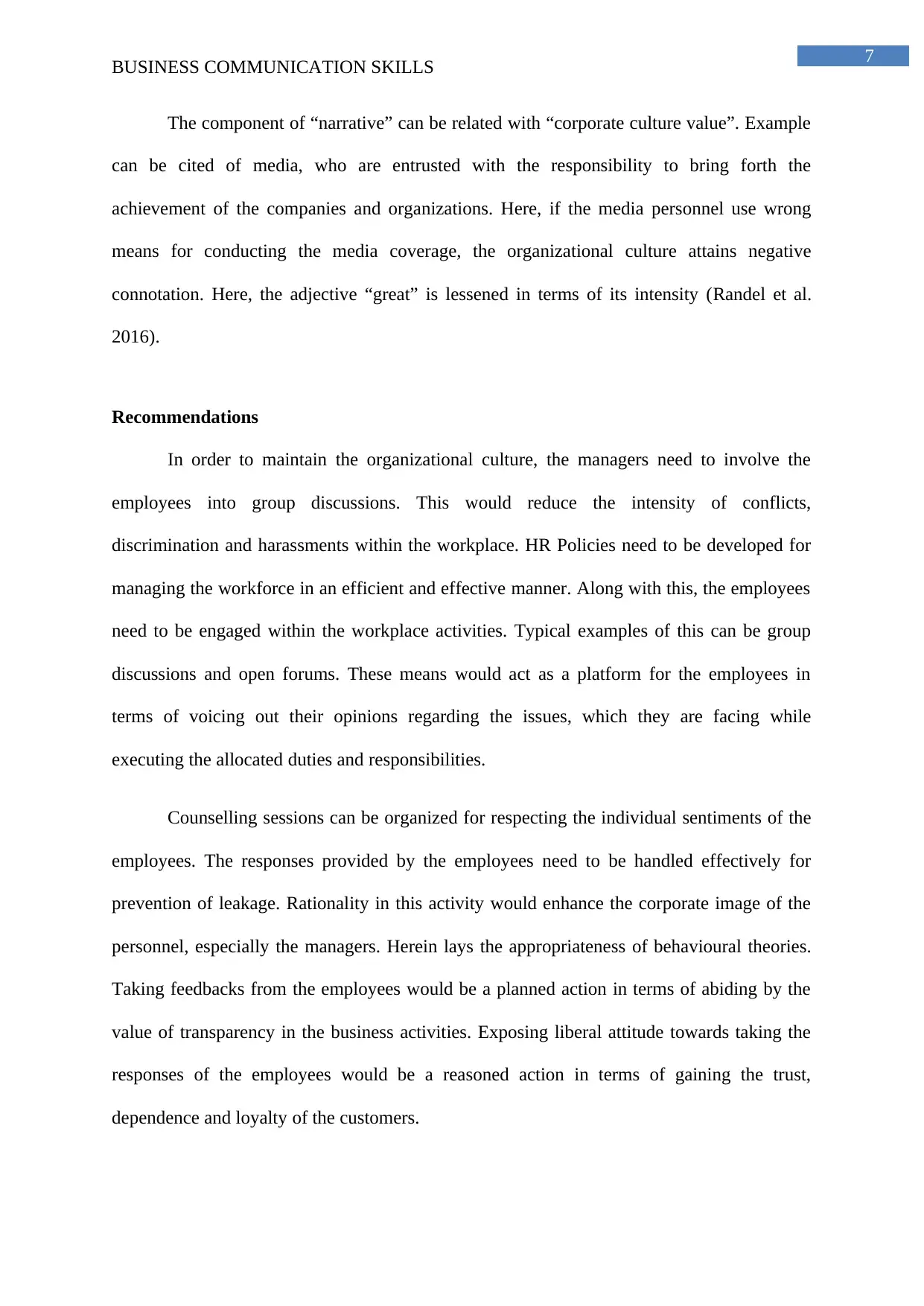
7
BUSINESS COMMUNICATION SKILLS
The component of “narrative” can be related with “corporate culture value”. Example
can be cited of media, who are entrusted with the responsibility to bring forth the
achievement of the companies and organizations. Here, if the media personnel use wrong
means for conducting the media coverage, the organizational culture attains negative
connotation. Here, the adjective “great” is lessened in terms of its intensity (Randel et al.
2016).
Recommendations
In order to maintain the organizational culture, the managers need to involve the
employees into group discussions. This would reduce the intensity of conflicts,
discrimination and harassments within the workplace. HR Policies need to be developed for
managing the workforce in an efficient and effective manner. Along with this, the employees
need to be engaged within the workplace activities. Typical examples of this can be group
discussions and open forums. These means would act as a platform for the employees in
terms of voicing out their opinions regarding the issues, which they are facing while
executing the allocated duties and responsibilities.
Counselling sessions can be organized for respecting the individual sentiments of the
employees. The responses provided by the employees need to be handled effectively for
prevention of leakage. Rationality in this activity would enhance the corporate image of the
personnel, especially the managers. Herein lays the appropriateness of behavioural theories.
Taking feedbacks from the employees would be a planned action in terms of abiding by the
value of transparency in the business activities. Exposing liberal attitude towards taking the
responses of the employees would be a reasoned action in terms of gaining the trust,
dependence and loyalty of the customers.
BUSINESS COMMUNICATION SKILLS
The component of “narrative” can be related with “corporate culture value”. Example
can be cited of media, who are entrusted with the responsibility to bring forth the
achievement of the companies and organizations. Here, if the media personnel use wrong
means for conducting the media coverage, the organizational culture attains negative
connotation. Here, the adjective “great” is lessened in terms of its intensity (Randel et al.
2016).
Recommendations
In order to maintain the organizational culture, the managers need to involve the
employees into group discussions. This would reduce the intensity of conflicts,
discrimination and harassments within the workplace. HR Policies need to be developed for
managing the workforce in an efficient and effective manner. Along with this, the employees
need to be engaged within the workplace activities. Typical examples of this can be group
discussions and open forums. These means would act as a platform for the employees in
terms of voicing out their opinions regarding the issues, which they are facing while
executing the allocated duties and responsibilities.
Counselling sessions can be organized for respecting the individual sentiments of the
employees. The responses provided by the employees need to be handled effectively for
prevention of leakage. Rationality in this activity would enhance the corporate image of the
personnel, especially the managers. Herein lays the appropriateness of behavioural theories.
Taking feedbacks from the employees would be a planned action in terms of abiding by the
value of transparency in the business activities. Exposing liberal attitude towards taking the
responses of the employees would be a reasoned action in terms of gaining the trust,
dependence and loyalty of the customers.
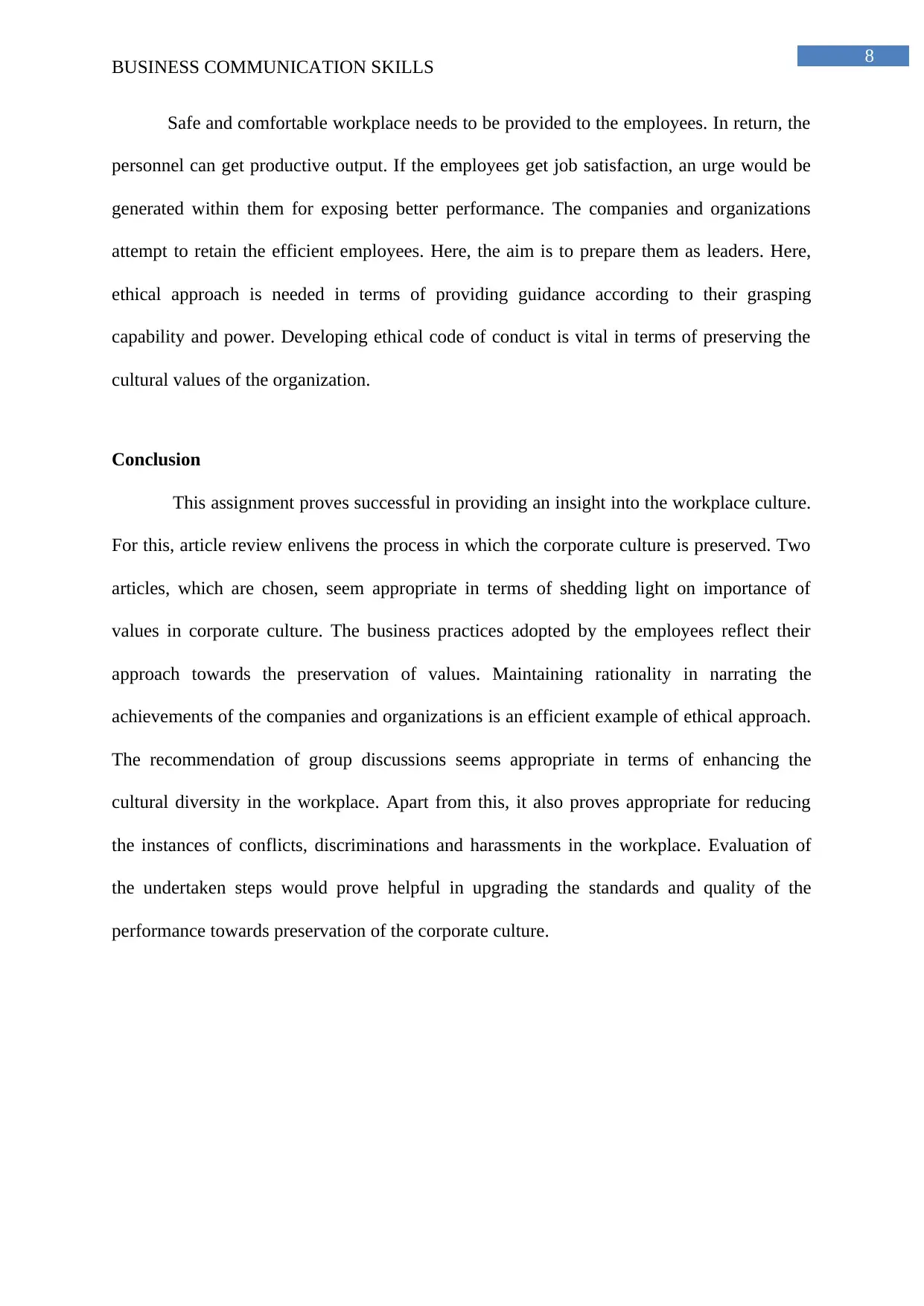
8
BUSINESS COMMUNICATION SKILLS
Safe and comfortable workplace needs to be provided to the employees. In return, the
personnel can get productive output. If the employees get job satisfaction, an urge would be
generated within them for exposing better performance. The companies and organizations
attempt to retain the efficient employees. Here, the aim is to prepare them as leaders. Here,
ethical approach is needed in terms of providing guidance according to their grasping
capability and power. Developing ethical code of conduct is vital in terms of preserving the
cultural values of the organization.
Conclusion
This assignment proves successful in providing an insight into the workplace culture.
For this, article review enlivens the process in which the corporate culture is preserved. Two
articles, which are chosen, seem appropriate in terms of shedding light on importance of
values in corporate culture. The business practices adopted by the employees reflect their
approach towards the preservation of values. Maintaining rationality in narrating the
achievements of the companies and organizations is an efficient example of ethical approach.
The recommendation of group discussions seems appropriate in terms of enhancing the
cultural diversity in the workplace. Apart from this, it also proves appropriate for reducing
the instances of conflicts, discriminations and harassments in the workplace. Evaluation of
the undertaken steps would prove helpful in upgrading the standards and quality of the
performance towards preservation of the corporate culture.
BUSINESS COMMUNICATION SKILLS
Safe and comfortable workplace needs to be provided to the employees. In return, the
personnel can get productive output. If the employees get job satisfaction, an urge would be
generated within them for exposing better performance. The companies and organizations
attempt to retain the efficient employees. Here, the aim is to prepare them as leaders. Here,
ethical approach is needed in terms of providing guidance according to their grasping
capability and power. Developing ethical code of conduct is vital in terms of preserving the
cultural values of the organization.
Conclusion
This assignment proves successful in providing an insight into the workplace culture.
For this, article review enlivens the process in which the corporate culture is preserved. Two
articles, which are chosen, seem appropriate in terms of shedding light on importance of
values in corporate culture. The business practices adopted by the employees reflect their
approach towards the preservation of values. Maintaining rationality in narrating the
achievements of the companies and organizations is an efficient example of ethical approach.
The recommendation of group discussions seems appropriate in terms of enhancing the
cultural diversity in the workplace. Apart from this, it also proves appropriate for reducing
the instances of conflicts, discriminations and harassments in the workplace. Evaluation of
the undertaken steps would prove helpful in upgrading the standards and quality of the
performance towards preservation of the corporate culture.
⊘ This is a preview!⊘
Do you want full access?
Subscribe today to unlock all pages.

Trusted by 1+ million students worldwide
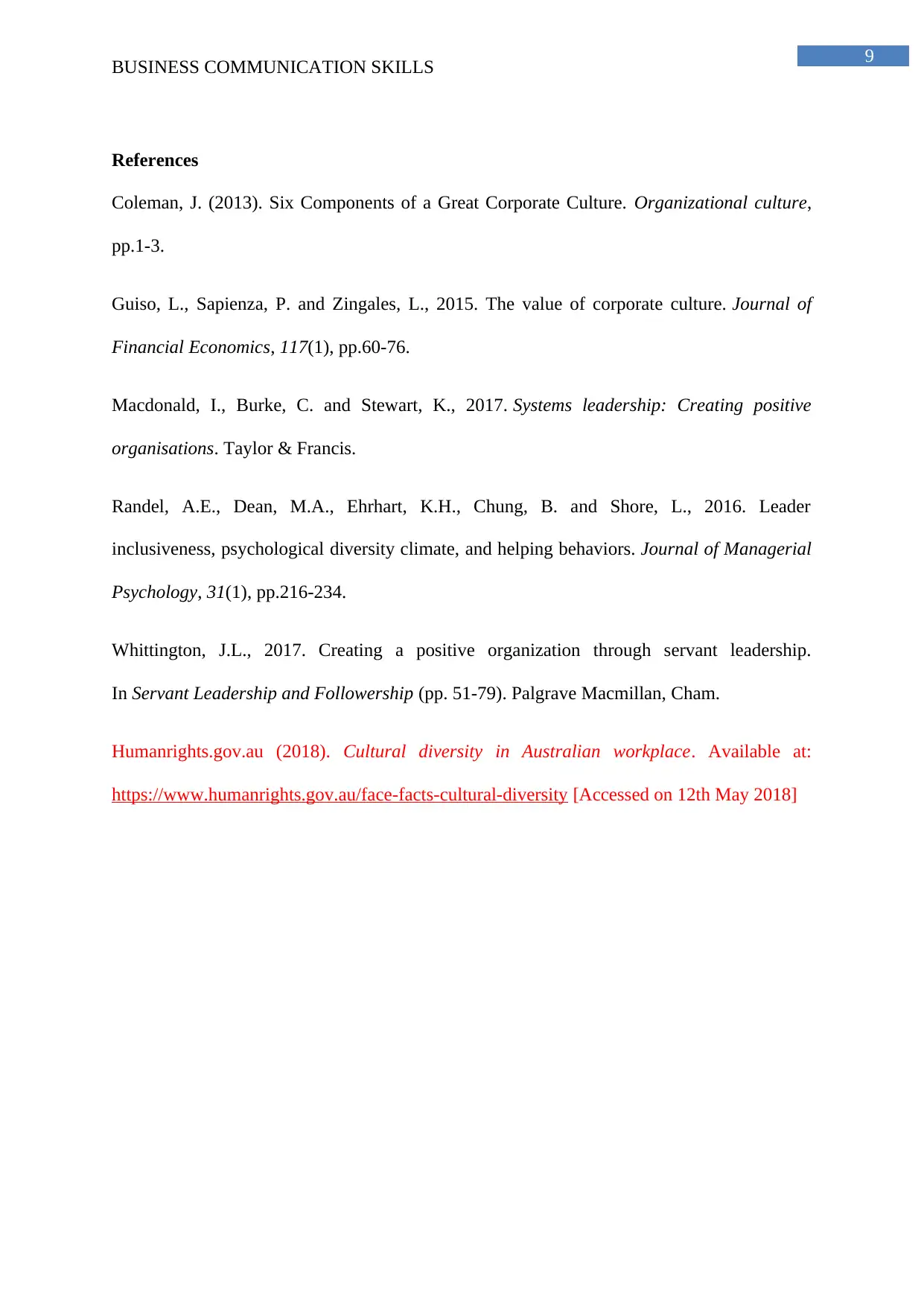
9
BUSINESS COMMUNICATION SKILLS
References
Coleman, J. (2013). Six Components of a Great Corporate Culture. Organizational culture,
pp.1-3.
Guiso, L., Sapienza, P. and Zingales, L., 2015. The value of corporate culture. Journal of
Financial Economics, 117(1), pp.60-76.
Macdonald, I., Burke, C. and Stewart, K., 2017. Systems leadership: Creating positive
organisations. Taylor & Francis.
Randel, A.E., Dean, M.A., Ehrhart, K.H., Chung, B. and Shore, L., 2016. Leader
inclusiveness, psychological diversity climate, and helping behaviors. Journal of Managerial
Psychology, 31(1), pp.216-234.
Whittington, J.L., 2017. Creating a positive organization through servant leadership.
In Servant Leadership and Followership (pp. 51-79). Palgrave Macmillan, Cham.
Humanrights.gov.au (2018). Cultural diversity in Australian workplace. Available at:
https://www.humanrights.gov.au/face-facts-cultural-diversity [Accessed on 12th May 2018]
BUSINESS COMMUNICATION SKILLS
References
Coleman, J. (2013). Six Components of a Great Corporate Culture. Organizational culture,
pp.1-3.
Guiso, L., Sapienza, P. and Zingales, L., 2015. The value of corporate culture. Journal of
Financial Economics, 117(1), pp.60-76.
Macdonald, I., Burke, C. and Stewart, K., 2017. Systems leadership: Creating positive
organisations. Taylor & Francis.
Randel, A.E., Dean, M.A., Ehrhart, K.H., Chung, B. and Shore, L., 2016. Leader
inclusiveness, psychological diversity climate, and helping behaviors. Journal of Managerial
Psychology, 31(1), pp.216-234.
Whittington, J.L., 2017. Creating a positive organization through servant leadership.
In Servant Leadership and Followership (pp. 51-79). Palgrave Macmillan, Cham.
Humanrights.gov.au (2018). Cultural diversity in Australian workplace. Available at:
https://www.humanrights.gov.au/face-facts-cultural-diversity [Accessed on 12th May 2018]
Paraphrase This Document
Need a fresh take? Get an instant paraphrase of this document with our AI Paraphraser
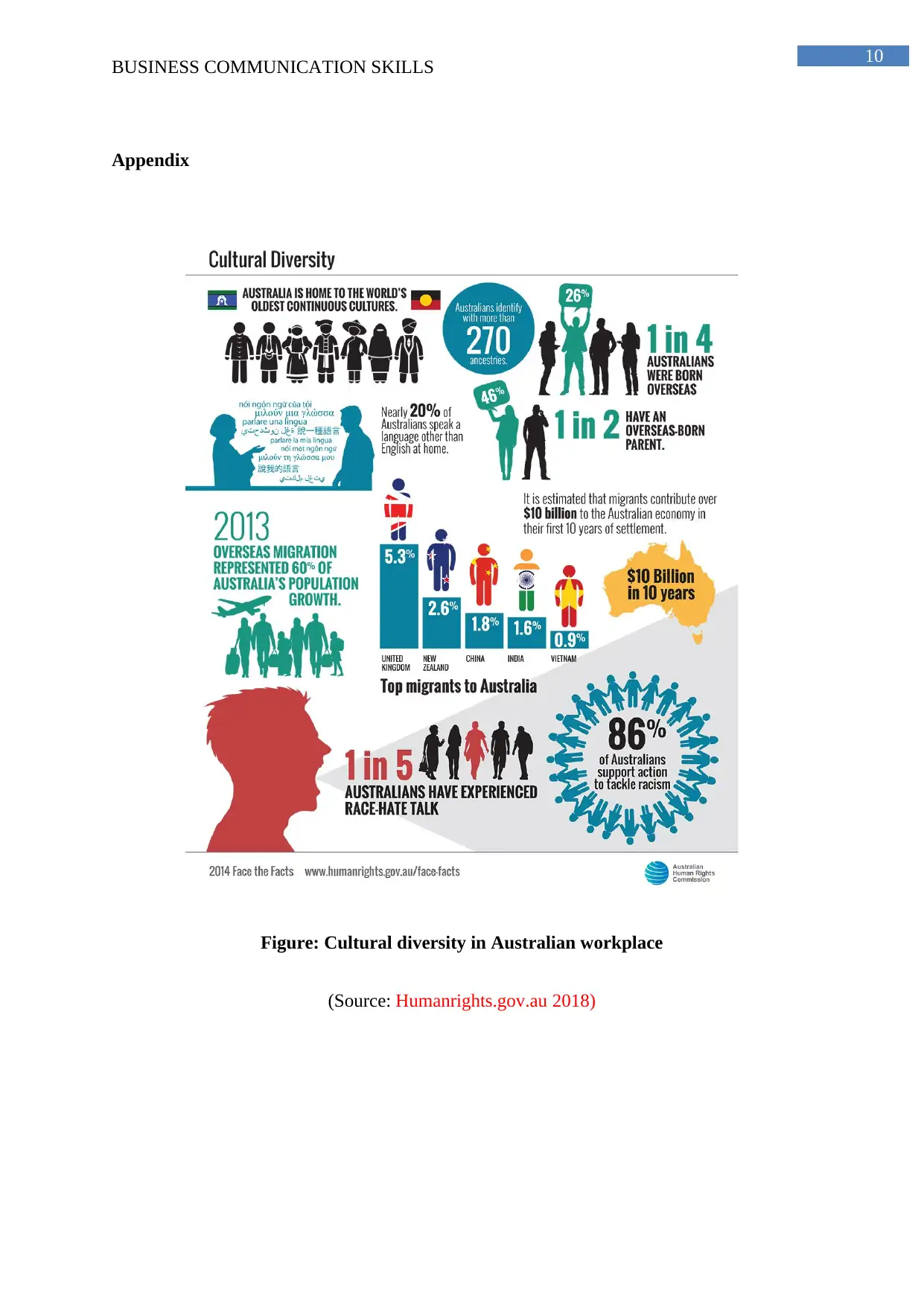
10
BUSINESS COMMUNICATION SKILLS
Appendix
Figure: Cultural diversity in Australian workplace
(Source: Humanrights.gov.au 2018)
BUSINESS COMMUNICATION SKILLS
Appendix
Figure: Cultural diversity in Australian workplace
(Source: Humanrights.gov.au 2018)
1 out of 11
Related Documents
Your All-in-One AI-Powered Toolkit for Academic Success.
+13062052269
info@desklib.com
Available 24*7 on WhatsApp / Email
![[object Object]](/_next/static/media/star-bottom.7253800d.svg)
Unlock your academic potential
Copyright © 2020–2025 A2Z Services. All Rights Reserved. Developed and managed by ZUCOL.





